Odin is a well-known figure in Norse mythology. He was said to travel around in disguises, and his depictions in popular culture are no different. Here's how Odin is depicted in the popular book and TV series American Gods.
American Gods is a 2017 TV show adapted from a 2001 book of the same name by British fantasy author, Neil Gaiman.
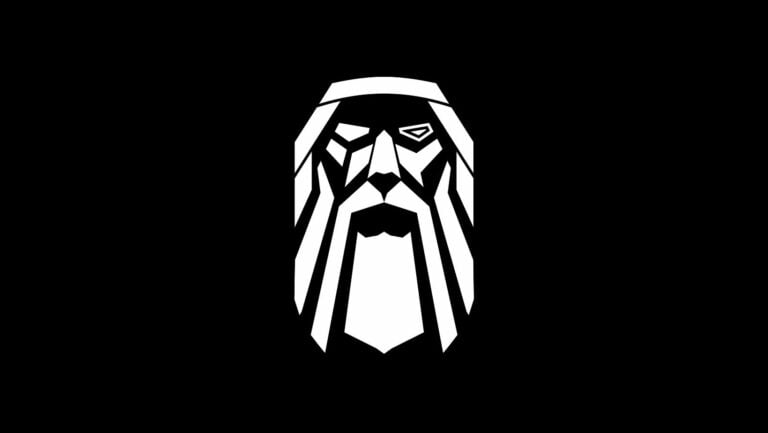
It centres on a young man named Shadow Moon, newly released from prison, who accepts a job as a security guard for the mysterious Mr. Wednesday and gets swept up into a hidden battle for survival between the Old Gods and the New Gods.
Note: this article contains spoilers for both the book and the TV series. If you haven't read the book or seen the series, I advise you to stop reading now! The spoilers begin right away…
Watching out for Odin
In Season 1, Episode 8, Mr. Wednesday reveals that he is, in fact, Odin, the Norse God of war, poetry, death and knowledge – among other things.
In mythology, Odin likes to travel around in disguises, and his depictions in popular culture are often no different. That said, while his reveal in American Gods is a very impressive moment in the show, it isn’t too much of a surprise if you know what to look for.
In the same way that Waldo (or “Wally” as he’s called at home in the UK) can be recognised by his stripey red-and-white shirt, round glasses and bobble hat, no matter how well he hides, Odin has some key features that tend to follow him from story to story, be it in books, art, film or music.
Therefore, we spent the weekend digging through Norse mythology and re-watching American Gods to come up with five things to look out for if you suspect a character is Odin.
1. Count the eyes
We’ll start with one of the biggest giveaways of Odin: the man only has one eye.
In mythology, Odin sacrifices an eye in exchange for a drink from Mimir’s well, presumably in exchange for the gift of foresight (ironically enough). His pursuit of knowledge doesn’t stop there either.
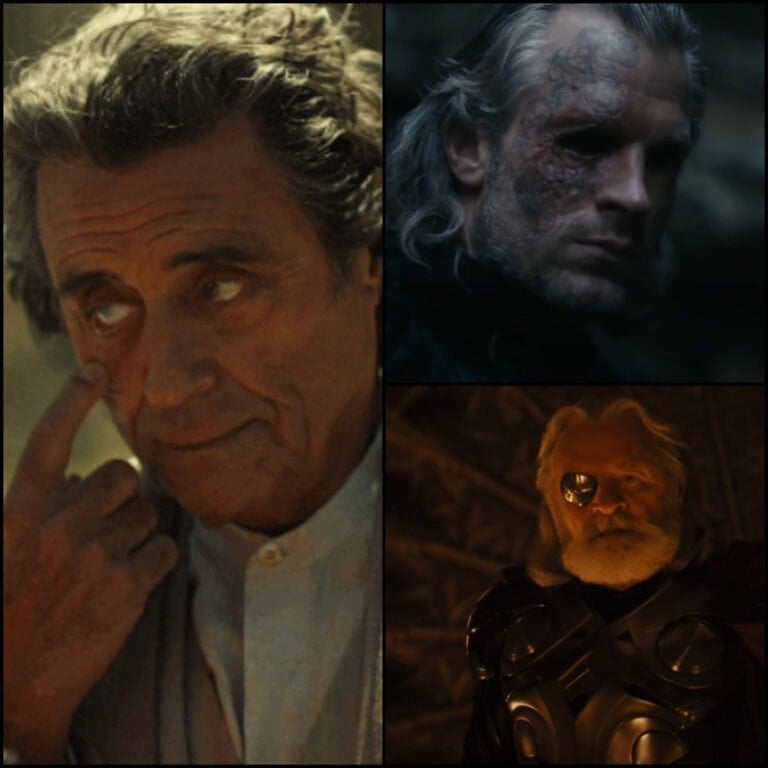
He also stabs himself with his own spear and hangs himself on Yggdrasil, the World Tree, for nine whole days and nights to learn the secrets of the runes.
Neither of those experiences seem particularly enjoyable, and I’m grateful to live in the 21st century, as I can just google something I don’t know rather than mutilate myself.
However, losing an eye undoubtedly leaves more of a noticeable physical mark than being hung. I have yet to see a depiction of Odin where he still has both of his eyes.
How this missing eye is shown varies in popular culture. In American Gods, Mr. Wednesday replaces his missing eye with a glass one, while in the 2011 movie Thor, Odin wears a shiny, space-pirate-esque eyepatch, and in the 2013 TV series Vikings, he just leaves it as a gaping hole.
Funnily enough, American Gods, Thor and Vikings all show Odin as having sacrificed his right eye.Yet, mythology doesn’t specify which eye Odin lost, and there’s plenty of artwork depicting Odin as missing his left eye.
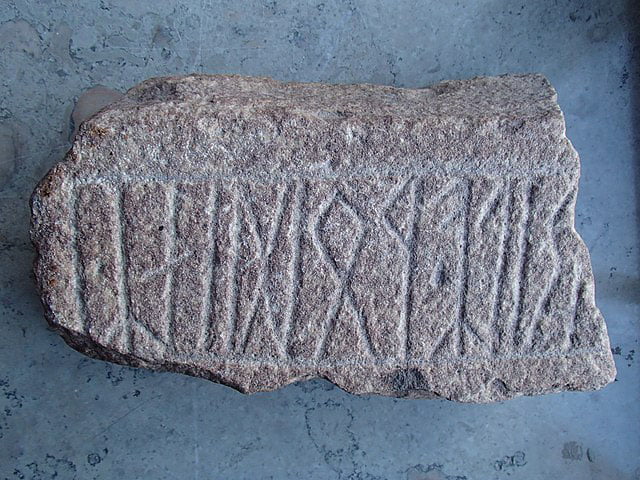
When in doubt however, if a character is missing either eye, there’s a good chance that it’s Odin.
2. A Wednesday connection
Mr. Wednesday: What’s today?
Shadow: Wednesday.
Mr. Wednesday: Hmm, today is my day.
– American Gods, Season 1, Episode 1
Odin’s choice to adopt the alias “Mr. Wednesday” in American Gods isn’t random. While Odin is predominantly a Norse God, he was also known throughout England and Germany as “Woden”, “Wodan” or “Votan”.
The word “Wednesday” comes from the Old English word: “Wodnesdæg”, which means “Woden’s day”. The Norwegian word “Onsdag” (Wednesday) has the same root, coming from the Old Norse word “óðinsdagr” or “Odin’s day”.
Mr. Wednesday is not the only depiction of Odin to reference the god’s connection to Wednesday. For example, in Dianna Wynne Jones’ fantasy novel Eight Days of Luke, Odin goes by “Mr. Wedding” and specifically enters the story on a Wednesday.
This strategy could also be used to identify other Norse Gods in hiding, as Odin isn’t the only Æsir to have a day named after them. Tyr has a similar relationship to Tuesday, as does Thor to Thursday, and Frigg to Friday.
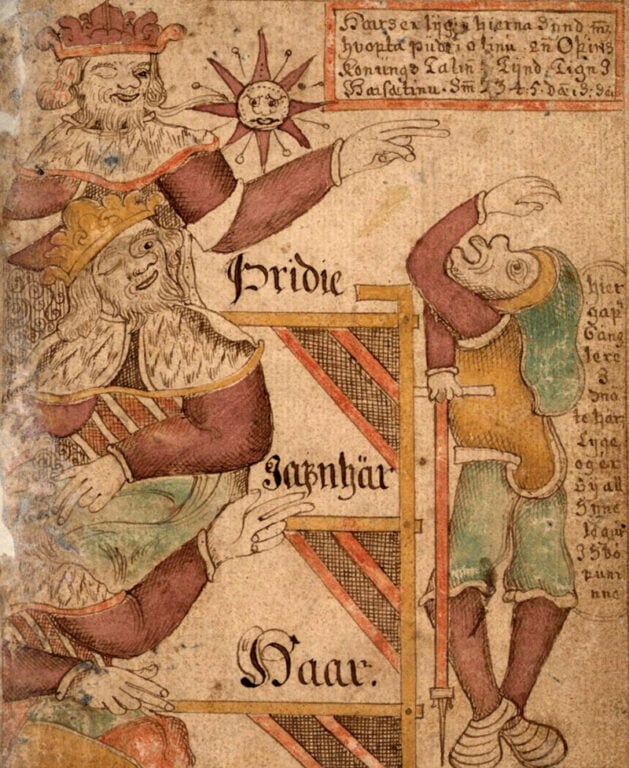
However, if someone enters the story on a Monday, Saturday or Sunday, then your guess is as good as mine.
3. The name game
Grimnir is one of Odin’s more well-known pseudonyms. In fact, in American Gods, Mr. Wednesday is outed as “Grimnir” long before he reveals he’s Odin. However, it is by no means his only name.
In Grímnismál (The Lay of Grimnir), he tells King Geirröth that he “hasn’t had a single name since he first began travelling among men” (einu nafni hétumk aldregi, síz ek með folkum fór), and provides an extensive – yet by no means complete – list of alternative names, including:
Grim, Grimnir, Gangleri, Herjan, Hjalmberi, Thekk, Thrithi, Thuth, Uth, Helblindi, Hor, Sath, Svipal, Sanngetal, Herteit, Hnikar, Bileyg, Baleyg, Bolverk, – deep breath– Fjolnir, Glapsvith, Fjolsvith, Sithhott, Sithskegg, Sigfather, Hnikuth, Allfather, Valfather, Atrith, Farmatyr, Kjalar, Vithur, Oski, Biflindi, Jafnhor, Omi, Gondlir and Harbarth.
A lot of the names given to Odin in the sagas are kennings. Kennings are used a lot in Old Icelandic and Old English poetry to refer to someone or something by a descriptor or trait instead of a name. For example, a kenning for me might be “the small, angry one” (especially before my morning coffee) or “hater of liquorice”.
My favourite kenning ever has to be “sea-pig”, which means “whale”.
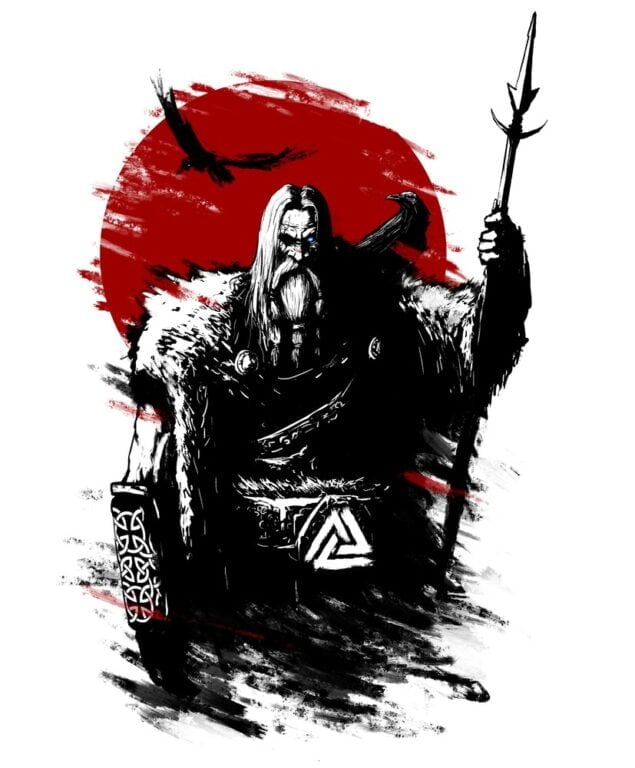
Kennings for Odin range from “Hangadróttinn” (“Lord of the Hanged”, for obvious reasons) to “Bági ulfs” (“Enemy of the wolf” – “the wolf” here being Fenrir).
However, his most well-known kenning is “Allfather”. While Odin is by no means the father of everything, or even the father of all the Æsir, he presumably received this title for his pivotal role in creating the world.
4. The company he keeps
“Hey,” said Shadow. “Huginn or Muninn, or whoever you are.”
The bird turned, head tipped, suspiciously, on one side, and it stared at him with bright eyes.
“Say ‘Nevermore,'” said Shadow.
“F*ck you,” said the raven.”
– American Gods, Neil Gaiman
Even if Odin has gone completely incognito – maybe he’s got a really convincing glass eye and adopted the name “John” – he can still be identified by his companions.
Namely, his two ravens Huginn and Muninn (Thought and Memory), two wolves Freki and Geri (whose names both translate to “the Ravenous One”), and his eight-legged horse Sleipnir (who is actually Loki’s son).
The ravens in particular often accompany Odin throughout popular culture. They act as both his spies and his messengers, flying all over the world before returning to him and reporting everything they have seen.
Odin might also be identified via his sons, as he’s father to some of the more famous gods in the Norse pantheon.
In the Poetic Edda, Thor, Baldr, Vidarr and Vali are explicitly named as Odin’s sons, while the Prose Edda adds more gods to this lineage, including Höd, Bragi, Hermod, Heimdall and Tyr (although in Hymiskviða, Tyr is said to be the son of the Jötunn Hymir).
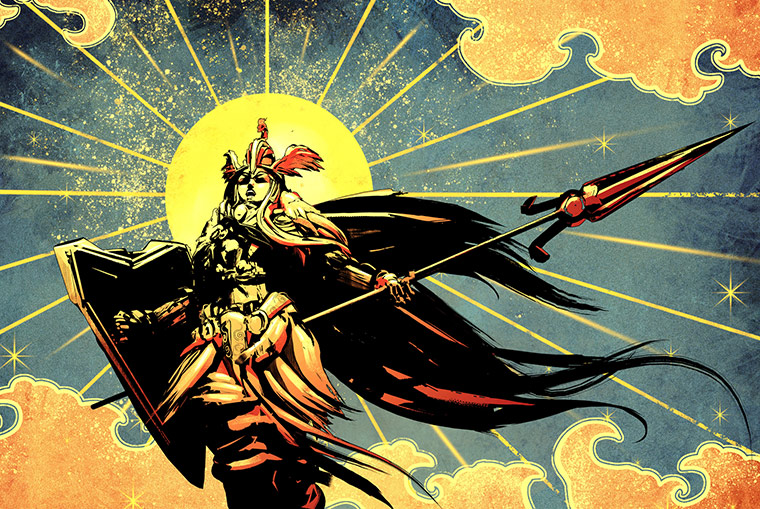
Finally, as a god of war and death, Odin receives half of the souls of those who died in battle. These souls are transported to either Odin’s hall Valhalla or Freyja’s home in Fólkvangr by beautiful, female creatures called the valkyries.
While the valkyries do not serve Odin specifically, their presence means that there is a 50-50 chance of encountering Odin shortly after.
5. Conning a con man
Ian McShane, the actor who plays Mr. Wednesday, describes his character as “a small-time grifter, a conman”. These may seem like unflattering words to describe a god – but it’s a pretty accurate description of Odin’s behaviour in Norse mythology.
Hanging himself on Yggdrasil and poking out his eye may have made Odin extremely cunning and knowledgeable, but it didn’t make him a good person. As a taster, his actions in the sagas include:
- Stealing the Mead of Poetry from Suttungr by “seducing” and subsequently abandoning Suttungr’s daughter, Gunnlöd (Skáldskaparmál)
- Becoming so jealous when he hears how Freyja got the magical necklace Brisingamen that he gets Loki to steal it and refuses to give it back until she agrees to perform some ridiculous tasks for him (Sörla þáttr)
- Fathering a child (Vali) with the specific purpose of killing Höd (his son) for being tricked into killing Baldr (his other son) by Loki (Skáldskaparmál)
- Tricking Fenrir into being bound simply because the Æsir got scared of how big he was getting (technically this is a group effort, but since Fenrir kills Odin in Ragnarok, it’s fair to assume that Odin plays a key part in this) (Gylfaginning).
Odin often fixates on what he wants and stops at nothing to get it, no matter how taboo his methods.
For example, he practises seid, which is a type of magic brought to the Æsir by Freyja.
While there were male practitioners, it was considered shameful for men to practice seid due to its specific association with the feminine.
In this respect, Odin has a lot in common with his blood brother Loki, who also shows little regard for social norms, particularly in relation to gender.
However, while Loki is often ridiculed, punished and framed in a negative light, Odin seems to be immune to such judgement, and his position as chief of the Æsir goes unchallenged.
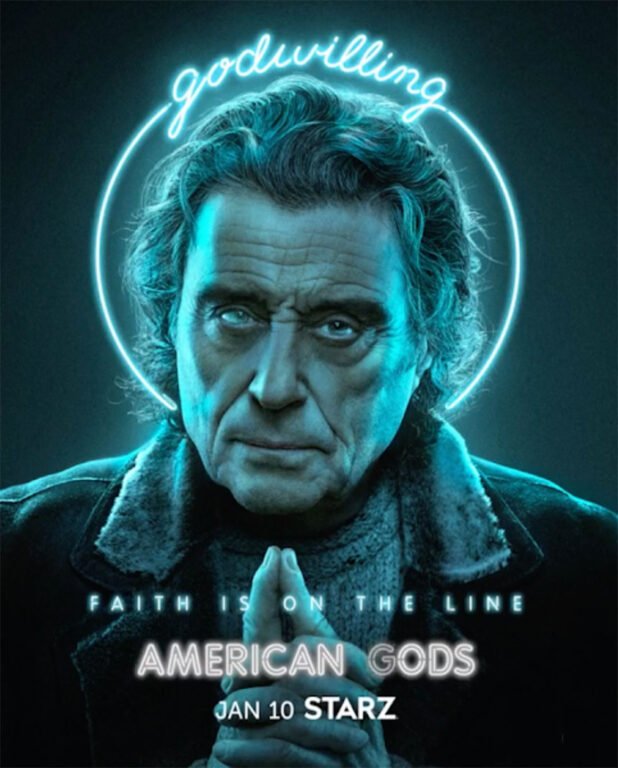
Therefore if you encounter a character that seems clever and charming, yet simultaneously tricky and untrustworthy, there’s a very high chance that it’s Odin… or Loki.
The end?
American Gods was cancelled after its third season, which ended with the apparent death of Mr. Wednesday (an event that happens about halfway through the book).
However, whether Mr. Wednesday actually is dead is left up to debate (unless you’ve read the book). In the words of Ian McShane:
“How do you know he’s dead? You never know anything with Wednesday. Maybe Wednesday planned the whole thing. Have you thought about that? Knowing Wednesday, that’s my question. He’s dead, but how do you know he didn’t plot it all? Everything’s coming full circle again.”
American Gods and Mr. Wednesday might have come to an end, but you can still find Odin alive and well in other Old Norse adaptations – and perhaps even other places. It’s just a matter of knowing where to look.
What do you think of Odin? Do you have a favourite book or series inspired by Norse mythology? Let us know in the comments.


Thank you! This is SO interesting! I have Norwegian ancestry, but I know too little about the “old gods.” I think Loki is fascinating, too. I would like to get a copy of this book and read it….and I would like to be able to use runes effectively. (But I don’t plan to hang myself on Yggdrasil.)
I am sad about the wolves. But I do understand. With these stories about the wolf it seems very clear that wolves were a real problem, and it is such a fearful thought, wolves coming and eating….. animals…..maybe people? I would like to know more about this, too.
Very good article! Thanks!